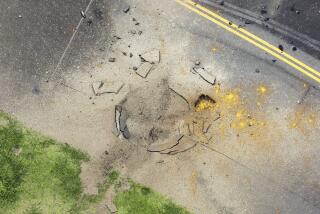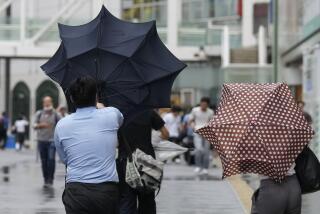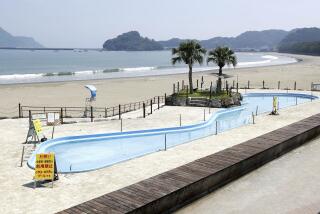Large Quake Rocks Japan
- Share via
TOKYO — A strong earthquake hit northeastern Japan on Monday evening, sparking fires, snarling communications, halting bullet trains and causing skyscrapers to sway in Tokyo, about 250 miles south. Nearly 80 injuries were reported, including six listed as serious.
According to Japan’s Meteorological Agency, the temblor was a magnitude 7, the most powerful to hit the country in more than two years. The shaker was roughly equivalent in magnitude to the 1995 Kobe earthquake, also known as the Hanshin Awaji quake, which killed more than 6,400 people.
A big difference between the two, however, was that this one struck in a far less dense area of Japan known for its farms, fishing villages and relatively small cities. With the epicenter approximately 12 miles off the coast of Miyagi prefecture and approximately 44 miles beneath the sea, the quake’s destructive force was blunted.
“It is absolutely inconceivable that there could be damage similar to that after the Hanshin Awaji earthquake,” Yoshitada Konoike, minister of disaster management, told a news conference in Tokyo.
Thousands of people were stranded as inspectors checked roads and train tracks for damage. Service on the Tohoku bullet train line was canceled for at least 24 hours, according to Kyodo news agency, after cracks were found in the system’s infrastructure. Hundreds of people slept in trains in Sendai station.
Several dozen people were hurt, mostly by broken glass and falling objects, according to police reports; six of the injuries were described as serious. Three fires broke out, one at a power substation and two in homes.
An estimated 35,000 homes lost power temporarily, although most had their electricity switched back on within an hour. Phone systems were snarled, 10 families evacuated their residences fearing landslides, and government-owned broadcaster NHK reported one highway in northeastern Japan shut down completely.
“I was outside when it hit, and it was difficult to remain standing,” said Hideki Fujiwara, a city official in Ofunato, in Iwate prefecture. Japan’s Tohoku Electric Power Co. said a nuclear reactor in the area shut down automatically after sensors detected vibrations.
Manabu Murakami, 34, who works at a fish market in the town of Kesennuma, said the market is on reclaimed land just beside the water, and all he could think about as everything shook was the danger of a tsunami.
“It was terrifying,” he said. “I just grabbed the floor and held on as fluorescent bulbs smashed and a tea set fell to the floor.” The government later said there was no risk of a tidal wave.
Monday’s quake came 20 years to the day after a major temblor in Akita prefecture shook the area, killing 104 people. Every year, Akita officials hold disaster prevention drills on the anniversary, which they conducted a few hours before Monday’s quake. Local safety official Yoshinari Tomatsu said he believed the relatively modest damage in Akita was due in part to the timely drills.
*
Magnier reported from Seoul and Ueno from Tokyo. Rie Sasaki in The Times’ Tokyo Bureau contributed to this report.
More to Read
Sign up for Essential California
The most important California stories and recommendations in your inbox every morning.
You may occasionally receive promotional content from the Los Angeles Times.










